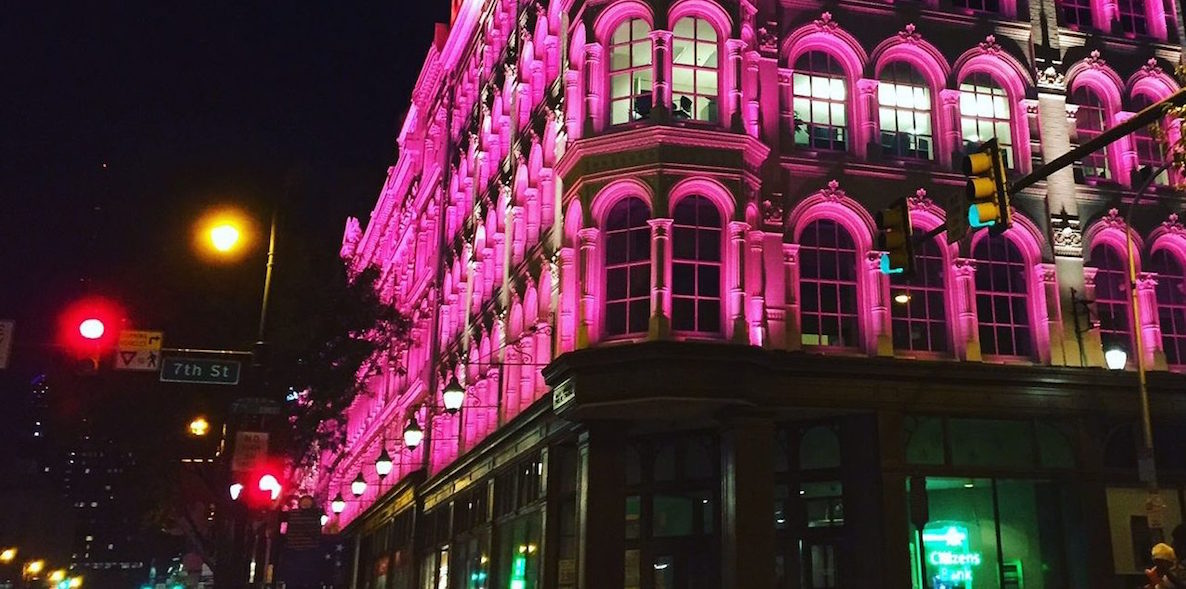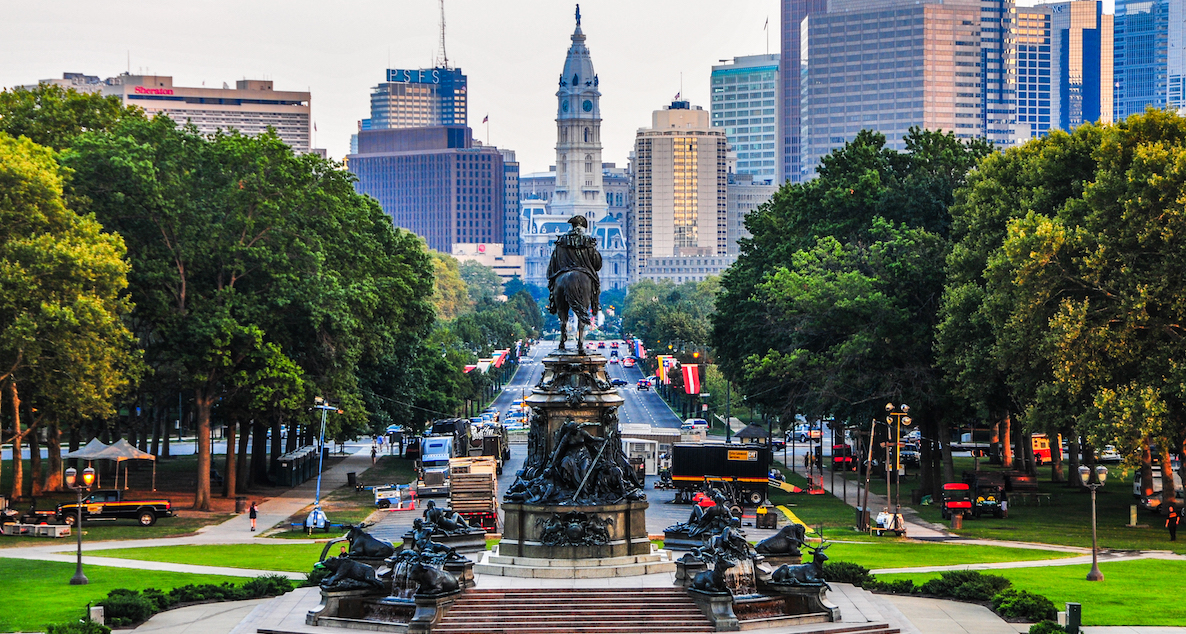For the better part of the last half century, the swath of California land bound by San Jose to the south and San Francisco to the north has exerted a black hole-like gravitational pull on the world’s financial and intellectual resources. Today, the tech colossi of Facebook, Apple and Alphabet—which together comprise sixty percent of the planet’s five most valuable companies—are all neighbors in the extended bayside community known as Silicon Valley. But after twenty-odd years of channeling seeming endless troves of money and brainpower into innovations from the indescribably sublime (Google, the iPhone) to the indescribably stupid (Juicero, Potato Parcel), there are signs that things are coming apart at the seams.
And as the Valley arguably enters an era of decline, opportunity for cities like Philadelphia arise. If we commit ourselves to visionary thinking, could we be one of the nation’s new meccas of innovation?
Silicon Valley, like our country, is in as precarious a state as it’s ever been. Our city and region—racially diverse, ethnically varied, proud of our attitude towards immigrants—can offer a fresh change of pace to an industry at risk of alienating the visionary minds that created it in the first place.
A deep dive into the challenges facing Silicon Valley might just illuminate a strategic path forward for us. After all, as a matter of personal cost-benefit analysis, Silicon Valley has become simply too expensive to live. And since many residents have analyzed that they would in fact like to live, an exodus has begun. In 2017, San Francisco experienced a net loss of people, and the number of respondents to a recent survey indicating plans to leave the Bay Area increased 14 points to 46 percent since 2016. With median home prices in the region scaling four times the national average, it’s no surprise that even relatively well-compensated tech workers (to say nothing of the displaced and disregarded non-tech population) are finding themselves stretched thin.
As if finding an affordable place to live weren’t enough of a barrier to entry for talent-rich but cash-poor new entrepreneurs, the omnipresent dominance of the consumer-internet behemoths is suppressing new startup activity in other ways as well. For one thing, the median salary at a giant like Facebook is $240,000; that may be just about enough to cover the rent on a $4,000/month one-bedroom apartment in San Francisco, but it’s also a lot more than a fledgling startup with long odds for success can afford to pay its employees. When putting a roof over your head means going where the money is, that’s where you’re going to go. As a result, initial financing rounds for American startups have decreased by some 22 percent over the past six years.
For a place that built the sci-fi future we presently inhabit, Silicon Valley’s venture capital sector is shockingly (though not surprisingly) retrograde in its investment attitudes. As John Doerr, an Intel veteran, TED Talk alum and a billionaire eight times over thanks to his bets on Google, Amazon and Intuit has put it: “Invest in white male nerds who’ve dropped out of Harvard or Stanford.” It doesn’t take a genius’s gifts of perception to dissect this glib comment for what it really is: racist, sexist and elitist.
Articles by Ajay Raju Read More
What’s truly astounding is how un-scandalous such an observation like Doerr’s is within the venture capital monoculture. In a demimonde more fixated on correlating data points than on sociological inquiry, the numbers bear out Doerr’s galling heuristic. Less than 5 percent of venture capital funding goes to women founders, less than 1 percent goes to African Americans, and in the period from 2007 to 2012, 10 percent of all startup financing worldwide went collectively to alumnae of Stanford, Harvard, Berkely, MIT, NYU and Penn.
Beyond its tendency to lavish investment dollars on caucasian sons of the Ivy League, Silicon Valley’s corporate gender dynamics are dismally similar to businesses anywhere and everywhere. Google, for example, denies accusations by the Department of Labor that it pays its female employees markedly less than their male counterparts, and a survey of hundreds of women in the Valley found that two-thirds felt left out of opportunities for strategic networking, to say nothing of the 60 percent who experienced unwanted sexual advances from coworkers. The view isn’t any better from the top of the corporate ladder; women comprise only 6 percent of venture capital partners, and not even 40 of the 100 leading venture firms have a female partner in charge of investment decisions. Against a raft of statistical studies demonstrating that diverse teams yield better results—the kind of studies one would expect VC pros to find compelling—Silicon Valley persists as a big homogenous fraternity row.
Colorado Governor John Hickenlooper defines topophilia as, simply, “love of place.” If you give people meaning where they live, what you’re really doing is imparting a sense of freedom to create.
It’s difficult not to see parallels between this sort of elitist insularity and the more populist, chauvinist variety that has spewed like so much hog waste into the mainstream of American political culture since the ascent of Donald Trump. Just as Trump’s bigoted and benighted policies have slammed the door on our national self-image of a pluralist success story, the billionaire boys clubs of Wall Street and Palo Alto continue to reproduce the lily white robber barons of the last Gilded Age, only this time having replaced their cravats and waistcoats with oxford collars and v-neck sweaters.
There is a perverse irony in the similarities between the prejudiced tendencies of the Trump administration and the business practices of the elite American tech sector. While Trump doubles down and doubles down again on outright xenophobia, more than half of America’s top tech firms were founded by immigrants and the children of immigrants. Draconian new limits on work visas for immigrants means a depleted future workforce for the companies that rely on the skills of these newcomers, who tend to seek degrees in precisely the programming and engineering fields that tech finds so valuable. Even some venture capital firm leaders are projecting that these small-minded, hard-hearted policies could spell doom for Silicon Valley in the next decade.
It may be that the stratospheric costs of living and doing business in Silicon Valley, combined with a chaotic and ugly national political landscape in which the industry’s worst tendencies have been brought into stark relief, mark the tipping point of a new tech diaspora. Fifty percent of those leaving the valley are millennials, the cohort that will drive the American economy either across the horizon or into the gulch of its ultimate demise. In any case, this generation is looking back eastward to plant flags in the next promise lands of tech.
Miami-Fort Lauderdale has improbably taken the number one spot in America for start-up activity. And cities as disparate as Portland, Dallas, Vancouver and Pittsburgh are all on the map as home bases for innovators, entrepreneurs and the deep-pocketed venture capitalists that hover all around. Each of these locales has its own peculiar charms and selling points, but two things they all share are a far more manageable cost of living and well-regarded universities producing cutting edge research and ambitious young minds.
I’ve been in the habit lately of reminding ourselves that Philadelphia, a city that boasts both of these factors (and then some), can’t seem to get out of our own way when it comes to retaining talent and attracting creative capital investment. My complaints have usually been some variation on the theme of a sclerotic and unimaginative political class, given over to complacency, patronage and an archaic, unproductive approach to governance and civic development.
While I stand by those complaints and vow to continue to making them, it bears considering the argument from the other side. Silicon Valley, like our country, is in as precarious a state as it’s ever been, and perhaps the Ubers, the Alphabets and the Y Combinators need us as much (well, almost as much) as we claim to need them. All of this is to say that our city and region—racially diverse, ethnically varied, socioeconomically stratified, proud of our attitude towards immigrants and the dispossessed—can offer a fresh change of pace to an industry at risk of alienating the visionary minds that created it in the first place.
But how do we convince the vanguard of the tech and venture capital sectors to turn their attentions away from the coasts and to re-conceptualize the geography of their investment strategies? Perhaps we just need to teach them one new word. The VC community seems to love its holophrases: “incubate,” “accelerate,” “longtail,” “freemium,” and of course, the mythical “unicorn.” These are all words that serve as shorthand for more involved concepts central to the investment universe. It’s time to introduce another such phrase: “topophilia.”
Steal ideas on November 30thDo Something
The concept of topophilia was introduced into the investment lexicon by Colorado Governor—and Narberth native—John Hickenlooper, who will be one the featured speakers at The Citizen’s upcoming Ideas We Should Steal Festival. If you’re wondering what the chief executive of the Rocky Mountain State knows about the innovation economy, take note that in the Kauffman Foundation’s 2016 ranking of the best American cities for entrepreneurship, four of the top ten were in Colorado. Along with Ross Baird, author of the illuminating book The Innovation Blind Spot, Hickenlooper defines topophilia as, simply, “love of place.” If you give people meaning where they live, what you’re really doing is imparting a sense of freedom to create.
It’s a revealing irony that the hotbeds of the technologies (and of the vast funding for those technologies) whose purported great offering is to connect everyone and everything, have become increasingly concentrated in exclusive geographic regions. This contradiction is due, at least in part, to the tendency of venture capital to seek out the “next great idea” with the best potential for fast, big returns, and with virtually no consideration for the contexts and communities in which great ideas take shape.
This failure of capital to invest in ecosystems—where collaboration and shared interest generate innovation that actually serves the common good—misses out on opportunities to generate sustainable returns. Just as frustrating, it results in an investment approach that rewards shallow, short-term gambles on the so-called “convenience economy” while giving short shrift to the real societal ills that could very well be cured with an adequate allocation of money, interest, and technological savoir-faire.
If we can spread the gospel of topophilia to Silicon Valley’s big brains and deep pockets, we might be able to divert some of that intellectual and financial firepower away from apps that sell you personally inscribed potatoes and toward technologies that help to alleviate hunger, poverty, and inequality. Topophilia has been the motive, if not the name, for the entrepreneurial renovation of economically dislocated American urban centers like Louisville, post-Katrina New Orleans, and deindustrialized Detroit. In Detroit, Quicken Loans founder Dan Gilbert and his Rock Ventures Family of Companies, comprising more than 100 distinct firms, is cultivating an all-encompassing ecosystem of civic renewal that touches everything from affordable and market rate housing to high-speed internet structure. But Gilbert’s aim is not to hedge one investment against another, but to create a symbiotic complex in which the success of any one particular investment enhances the prospects of the rest.
It’s no stretch to imagine the tremendous potential of topophilia here in Philadelphia. If this town can rally with lunatic passion around a monstrous abomination like Gritty, surely we can come together to invest in its revitalization. There’s no shortage of shared fond feeling for the City of Brotherly Love, but growing an innovation ecosystem means taking a hard, clear-eyed look at our seemingly intractable problems, and their as-yet untapped human solutions.
It’s been said many times (and it shouldn’t stop being said until it’s no longer true), that entrenched poverty is the scourge of this city. Just over a quarter of Philadelphians live below the poverty line, of which half struggle to scrape by at income levels of less than 50 percent of the poverty threshold. But what does that statistic mean in the lives of the individuals, families and communities who actually experience it? For starters, it means a scarcity of safe, affordable housing, lack of access to nutritious food, environmental exposure to pollution, drugs, crime and violence, poor health outcomes, lack of educational attainment, and a systematized state of despair that persists across generations. But each of these manifestations of poverty is material in nature, and that means they can and should be addressed through material intervention—or better yet, through material innovation.
To take nutrition for just one example, Philadelphia, like many big, poor American cities, is plagued with food deserts, those swaths of the city devoid of grocery stores carrying healthy food options. Residents of these areas, who are less likely to have cars, are forced either to travel long distances on public transportation to find produce and fresh ingredients, or to make do at nearby convenience stores, whose goods tend to be more expensive and far less healthy. To be sure, advocates in Philadelphia have already done some impressive work in fighting food deserts. Thanks to $74 million invested in full- and limited-services grocers, Philadelphia-based community development financial institution The Reinvestment Fund (TRF) reported a 56 percent drop between 2005 and 2013 in city residents without access to healthy food options.
The success of TRF’s initiative shows that throwing money at a problem can work, if your aim is true. But what if we sought to tackle nutrition inequality in Philadelphia not just by propping up more grocery stores in more underserved neighborhoods, but by empowering those neighborhoods to become stakeholders in an innovative, sustainable approach to eradicating our city’s food deserts? One answer that should appeal to entrepreneurial topophiles is urban vertical farming.
If this town can rally with lunatic passion around a monstrous abomination like Gritty, surely we can come together to invest in its revitalization. Growing an innovation ecosystem means taking a hard, clear-eyed look at our seemingly intractable problems, and their as-yet untapped human solutions.
As the name implies, vertical farming is an approach to agriculture that looks upward rather than out across expanses of fields. Its advent was prompted both by the ecological devastation that modern “horizontal” farming has wrought, and by the ever-increasing concentration of the world’s population into cities. For those of us with the disposable income to afford them, kiwis cumquats and coconuts can be ours to enjoy year-round. But the supply chains behind those indulgences (not to mention many other more humble fruits and vegetables) involve an unconscionable amount of carbon output just to grow, ship and store. As cities become more crowded and arable land becomes more degraded, the need to adapt agriculture to urban environments becomes all the more urgent.
In vertical farming, agricultural specialists (also known as farmers) have modified current methods of indoor growing to cultivate edible greens inside skyscraping warehouses, using LEDs in place of sunlight. By obviating the need for pesticides and applying machine learning technologies to optimize water and light inputs, vertical farming can vastly improve the efficiency of growing produce, reducing its cost and price at market. And in building vertical farms near the consumers that will purchase their goods, the environmental harms inherent in shipping and storage are vastly reduced. A concept as disruptive and tech-centric as vertical farming is bound to attract venture capitalists, and indeed it has. Japanese conglomerate SoftBank has already committed $200 million in Series B funding to a vertical agtech firm based in—surprise surprise—Silicon Valley.
Early big bets like SoftBank’s may validate the potential of vertical farming, but they don’t have to represent the only way to invest in these innovations. Here in Philadelphia, our government could very well partner with private investors and agtech engineers to develop vertical farming spaces in food deserts around the city. For example, public funding could replace the $65 million squandered on the city’s Office of Community Empowerment and Opportunity. And that money could be attached to strings that promote topophilia in substantive ways. For instance, to gain access to municipal funds, a vertical farming entrepreneur might have to enter into a binding commitment to hire members of the neighborhood at the site of the enterprise, pay a living wage, offer equity to workers and sell its goods at a discount to consumers within a certain radius. A public-private investment approach to local vertical farming enterprises might also incorporate topophilic principles on the talent side. In a minority-majority city like Philadelphia, it shouldn’t be difficult to recruit executives and other high-level skilled workers.
Another way that Philadelphia might advance community impact investment while tackling our longstanding brain-drain problem is by taking aim at a different monster: the student debt crisis. Aggregate student debt now totals approximately $1.5 trillion, more than credit card and car financing debt (and, it bears mentioning, the same amount as last summer’s Trump tax cut). In an economy where a college degree is a necessary but often insufficient condition for even hoping to reach the middle class, staggering student debt stifles the talents and forecloses on the futures of the young and educated. Income that graduates might otherwise use to seed their own start-ups is instead funneled toward unproductive debt service, and the best and brightest are compelled to seek a fat Facebook paycheck, rather than the more modest compensation of a smaller but more societally beneficial start-up.
Philadelphia could play a small but significant role in battling against this perversity by offering financial incentives, in the form of student loan repayment assistance, directly to local graduates who either launch or work for Philly-based start-ups dedicated to community investment. Such a tactic certainly won’t end the student loan crisis altogether, but if successfully deployed, could serve both as a model for other cities and as empirical proof of the benefits of not saddling our next generation of educated workers with insurmountable debt.
A giant like Amazon might scoff at modest conditions like these, but a scrappier upstart—especially one with existing local ties—would be likely to see the win-win potential in such an arrangement. Our city can be a leader in pushing back against the homogeneity and in-group bias of the VC and tech worlds by attaching meaningful diversity requirements to any public funding. Tactics like these would make a stronger case for using taxpayer dollars to subsidize for-profit businesses in the first place, and, by giving community stakeholders skin in the game and a piece of the pie, will strengthen the local roots and long-term viability of such an enterprise.
As Silicon Valley and the rest of the VC old guard continues to strain against the bloat and inequities that represent the societal costs of their hyper-aggressive, scorched earth approach to investment, new regions, new ideas and new strategies have a chance to vie for position. Philadelphia has woefully missed out on many prior opportunities, but we don’t have to miss out on this one. The power of our common interest will motivate and accelerate our move to the front of the pack. And harnessing that power requires articulating a common vision for the future our city, and how to get there. The basis for that vision, for that way forward, is our own topophilia: Our shared love of the place we call home.
Ajay Raju, an attorney and philanthropist, is chairman of DilworthPaxson and a founder/board member of The Citizen.
View of Philadelphia from Museum of Art - Philadelphia PA








